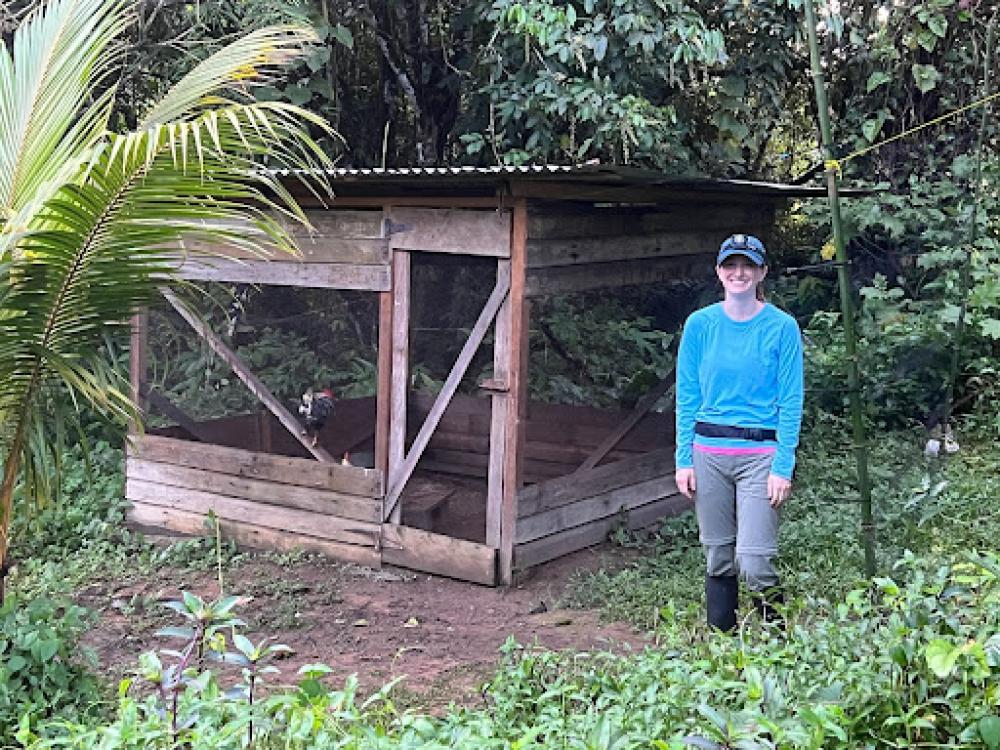Rising researcher: Lexi Frank’s fieldwork will power investigations for decades to come
May 8, 2023

CVM PhD student Lexi Frank in Kwebana Village, Guyana 2022
As a field researcher in training, Lexi Frank’s workday begins when the sun sets. That’s about the time that her nocturnal research subjects—neotropical bats in Guyana, South America—start to stir and leave their roosts. Bird activity goes down, too, making it less likely they’ll inadvertently get caught in the fine mist nets that the research team sets up in the areas where bats are likely to be flying.
The nets are undetectable to the bats visually or with echolocation, and Frank spends the next few hours gently untangling the animals they catch and hanging them in special bags that will keep them from experiencing stress. In the morning, the team turns to identifying and collecting samples from the bats.
Frank uses the samples to explore crucial questions about potential pathogens that the bats may host, as part of an interdisciplinary project focused on disease transmission risk from wildlife in Guyana. Bats—especially in areas where human development has created environmental disturbances—have been associated with global outbreaks of emerging infectious diseases such as Middle Eastern Respiratory Virus, SARS-CoV-2, and Ebola. And Guyana has some of the highest diversity of bat species in the world. There, bats live in both remote forested areas and in urban areas where they actively roost in homes and outbuildings, feed in gardens and agricultural fields, and interact with domestic animals and other wildlife. These interactions create opportunities to transmit disease to humans and animals.
Frank made her first trip to Guyana in June 2022, collecting samples from two sites—the first, an agricultural community with high levels of human disturbance and intensified agriculture; and the second, an Indigenous community with moderate disturbance, surrounded by forests.
Now, with a travel grant she recently received from the University of Minnesota Graduate School, Frank will return to Guyana in December to gather samples from a third site, the Konashen Community Owned Conservation Area (KCOCA)—ane extremely remote reserve managed by Indigenous Waiwai forager-horticulturalists in the south of Guyana. The expanses of intact forest and low levels of human disturbance at this new site will provide Frank with a way to compare the impact of different levels of human activity on the viral diversity and presence of pathogens within the bat populations.
Frank came to the University of Minnesota with an undergraduate degree in ecology and evolutionary biology and a Masters in public health, both from the University of Michigan, where she also worked as a mammalogist at the Michigan Museum of Zoology. She joined the Larsen Lab at CVM, where she works with Peter and Roxanne Larsen, both trained bat biologists. With 40 combined years of experience capturing and handling bats safely, they were well positioned to prepare Frank for her fieldwork. “Between her educational background, her experience in classical mammology—which is something of a lost art—and the way she’s shown herself to be a natural in the field, Lexi’s an integral part of our team,” said Peter Larsen.
Frank is eager to get back to the field—despite the challenges she knows to expect. “In the field, you have limited time, so you have to work really hard when you’re there to make the most of it,” says Frank. They’re really long days, and we’re wearing full PPE in tropical conditions while we work. But I love it.” At home, she’s also found that she loves working at the bench just as much, where she’s learning the high-tech genetic sequencing techniques that the Larsen lab uses to do much of its work.
While Frank’s not entirely sure which of these passions will drive her next steps when she finishes her PhD, the impact of the research she’s doing now will continue to ripple out—helping to develop a deeply collaborative relationship with the Indigenous communities where the lab works, enabling important new insights into the ecology of a potential hotspot for emerging disease, and ultimately sending the specimens she gathers to a biorepository where they will serve as a resource for researchers from all over the world for decades to come.
“The wealth of opportunities I’ve had here at CVM has been so exciting and rewarding,” Frank says. “It definitely makes me want to continue with research as a focus of my career.”


